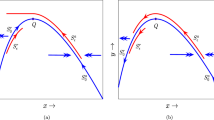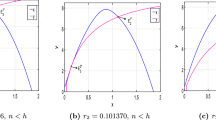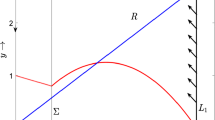Abstract
We study dynamics of a fast–slow Leslie–Gower predator–prey system with Allee effect and Holling Type II functional response. More specifically, we show some sufficient conditions to guarantee the existence of two positive equilibria of the system and their location, and then we further fully determine their dynamics. Based on geometric singular perturbation theory and the slow–fast normal form, we determine the associated bifurcation curve and observe canard explosion. Besides, we also find a homoclinic orbit to a saddle with slow and fast segments, in which, the stable and unstable manifolds of the saddle are connected under explicit parameters conditions.



Similar content being viewed by others
Data Availability
No datasets were generated or analysed during the current study.
References
Leslie, P.H.: Some further notes on the use of matrices in population mathematics. Biometrika 35(3/4), 213–245 (1948)
Leslie, P.: A stochastic model for studying the properties of certain biological systems by numerical methods. Biometrika 45(1–2), 16–31 (1958)
Hsu, S.B., Huang, T.W.: Global stability for a class of predator-prey systems. SIAM J. Appl. Math. 55(3), 763–783 (1995)
Hsu, S.B., Hwang, T.W.: Hopf bifurcation analysis for a predator–prey system of Holling and Leslie type. Taiwan. J. Math. 3(1), 35–53 (1999)
Korobeinikov, A.: A Lyapunov function for Leslie–Gower predator–prey models. Appl. Math. Lett. 14(6), 697–699 (2001)
Yuan, S., Song, Y.: Bifurcation and stability analysis for a delayed Leslie–Gower predator–prey system. IMA J. Appl. Math. 74(4), 574–603 (2009)
Holling, C.S.: The functional response of predators to prey density and its role in mimicry and population regulation. Mem. Entomol. Soc. Can. 97(S45), 5–60 (1965)
Huang, J., Ruan, S., Song, J.: Bifurcations in a predator–prey system of Leslie type with generalized Holling type III functional response. J. Differ. Equ. 257(6), 1721–1752 (2014)
Dai, Y., Zhao, Y., Sang, B.: Four limit cycles in a predator–prey system of Leslie type with generalized Holling type III functional response. Nonlinear Anal. Real World Appl. 50, 218–239 (2019)
Tiwari, V., Tripathi, J.P., Mishra, S., Upadhyay, R.K.: Modeling the fear effect and stability of non-equilibrium patterns in mutually interfering predator–prey systems. Appl. Math. Comput. 371, 124948 (2020)
Tripathi, J.P., Bugalia, S., Jana, D., Gupta, N., Tiwari, V., Li, J., Sun, G.Q.: Modeling the cost of anti-predator strategy in a predator-prey system: the roles of indirect effect. Math. Methods Appl. Sci. 45(8), 4365–4396 (2022)
Tripathi, J.P., Abbas, S., Thakur, M.: Dynamical analysis of a prey–predator model with Beddington–DeAngelis type function response incorporating a prey refuge. Nonlinear Dyn. 80, 177–196 (2015)
Tripathi, J.P., Abbas, S., Thakur, M.: A density dependent delayed predator-prey model with Beddington–DeAngelis type function response incorporating a prey refuge. Commun. Nonlinear Sci. Numer. Simul. 22(1–3), 427–450 (2015)
Allee, W., Bowen, E.S.: Studies in animal aggregations: mass protection against colloidal silver among goldfishes. J. Exp. Zool. 61(2), 185–207 (1932)
Tripathi, J.P., Mandal, P.S., Poonia, A., Bajiya, V.P.: A widespread interaction between generalist and specialist enemies: the role of intraguild predation and Allee effect. Appl. Math. Model. 89, 105–135 (2021)
Aguirre, P., Gonzalez-Olivares, E., Sáez, E.: Two limit cycles in a Leslie–Gower predator-prey model with additive Allee effect. Nonlinear Anal. Real World Appl. 10(3), 1401–1416 (2009)
Aguirre, P., González-Olivares, E., Sáez, E.: Three limit cycles in a Leslie-Gower predator-prey model with additive Allee effect. SIAM J. Appl. Math. 69(5), 1244–1262 (2009)
Aguirre, P.: A general class of predation models with multiplicative Allee effect. Nonlinear Dyn. 78(1), 629–648 (2014)
Zhu, Z., Chen, Y., Li, Z., Chen, F.: Stability and bifurcation in a Leslie–Gower predator–prey model with Allee effect. Int. J. Bifurc. Chaos 32(03), 2250040 (2022)
Zu, J., Mimura, M.: The impact of Allee effect on a predator-prey system with Holling type II functional response. Appl. Math. Comput. 217(7), 3542–3556 (2010)
Zu, J.: Global qualitative analysis of a predator-prey system with Allee effect on the prey species. Math. Comput. Simul. 94, 33–54 (2013)
Wang, C., Zhang, X.: Canards, heteroclinic and homoclinic orbits for a slow–fast predator–prey model of generalized Holling type III. J. Differ. Equ. 267(6), 3397–3441 (2019)
Su, W., Zhang, X.: Global stability and canard explosions of the predator–prey model with the Sigmoid functional response. SIAM J. Appl. Math. 82(3), 976–1000 (2022)
Chen, X., Zhang, X.: Dynamics of the predator-prey model with the Sigmoid functional response. Stud. Appl. Math. 147(1), 300–318 (2021)
Atabaigi, A.: Canard explosion, homoclinic and heteroclinic orbits in singularly perturbed generalist predator–prey systems. Int. J. Biomath. 14(01), 2150003 (2021)
Saha, T., Pal, P.J., Banerjee, M.: Slow-fast analysis of a modified Leslie–Gower model with Holling type I functional response. Nonlinear Dyn. 108(4), 4531–4555 (2022)
Zhu, Z., Liu, X.: Canard cycles and relaxation oscillations in a singularly perturbed Leslie–Gower predator-prey model with Allee effect. Int. J. Bifur. Chaos 32(05), 2250071 (2022)
Zhao, L., Shen, J.: Canards and homoclinic orbits in a slow–fast modified May–Holling–Tanner predator-prey model with weak multiple Allee effect. Discrete Contin. Dyn. Syst. B 27(11), 6745–6769 (2022)
Shi, T., Wen, Z.: Canard cycles and their cyclicity of a fast–slow Leslie–Gower predator–prey model with Allee effect. In: International Journal of Bifurcation and Chaos, accepted
Chowdhury, P.R., Banerjee, M., Petrovskii, S.: Canards, relaxation oscillations, and pattern formation in a slow–fast ratio-dependent predator-prey system. Appl. Math. Model. 109, 519–535 (2022)
Li, K., Li, S., Wu, K.: Relaxation oscillations and canard explosion of a Leslie–Gower predator-prey system with addictive Allee effect. Int. J. Bifurc. Chaos 32(11), 2250168 (2022)
Wen, Z., Shi, T.: Existence and uniqueness of a canard cycle with cyclicity at most two in a singularly perturbed Leslie-Gower predator-prey model with prey harvesting. Int. J. Bifurc. Chaos 34(03), 2450036 (2024)
Fenichel, N.: Geometric singular perturbation theory for ordinary differential equations. J. Differ. Equ. 31(1), 53–98 (1979)
Krupa, M., Szmolyan, P.: Relaxation oscillation and canard explosion. J. Differ. Equ. 174(2), 312–368 (2001)
Kuznetsov, Y.A., Muratori, S., Rinaldi, S.: Homoclinic bifurcations in slow–fast second order systems. Nonlinear Anal. Theory Methods Appl. 25(7), 747–762 (1995)
Shen, J.: Canard limit cycles and global dynamics in a singularly perturbed predator–prey system with non-monotonic functional response. Nonlinear Anal. Real World Appl. 31, 146–165 (2016)
Krupa, M., Szmolyan, P.: Extending geometric singular perturbation theory to nonhyperbolic points–fold and canard points in two dimensions. SIAM J. Math. Anal. 33(2), 286–314 (2001)
Lu, M., Huang, J.: Global analysis in Bazykin’s model with Holling II functional response and predator competition. J. Differ. Equ. 280, 99–138 (2021)
Author information
Authors and Affiliations
Contributions
T.S. carried out the investigation, prepared figure 1 and wrote the original draft manuscript. Z.W. convinced the study, verified the investigation and wrote the main manuscript. All authors reviewed the manuscript.
Corresponding author
Ethics declarations
Conflict of interest
The authors declare no conflict of interest
Additional information
Publisher's Note
Springer Nature remains neutral with regard to jurisdictional claims in published maps and institutional affiliations.
This work is partially supported by the National Natural Science Foundation of China (12071162), the Natural Science Foundation of Fujian Province (No. 2021J01302) and the Fundamental Research Funds for the Central Universities (No. ZQN–802).
Rights and permissions
Springer Nature or its licensor (e.g. a society or other partner) holds exclusive rights to this article under a publishing agreement with the author(s) or other rightsholder(s); author self-archiving of the accepted manuscript version of this article is solely governed by the terms of such publishing agreement and applicable law.
About this article
Cite this article
Shi, T., Wen, Z. Canard Cycles and Homoclinic Orbit of a Leslie–Gower Predator–Prey Model with Allee Effect and Holling Type II Functional Response. Qual. Theory Dyn. Syst. 23, 197 (2024). https://doi.org/10.1007/s12346-024-01059-z
Received:
Accepted:
Published:
DOI: https://doi.org/10.1007/s12346-024-01059-z




